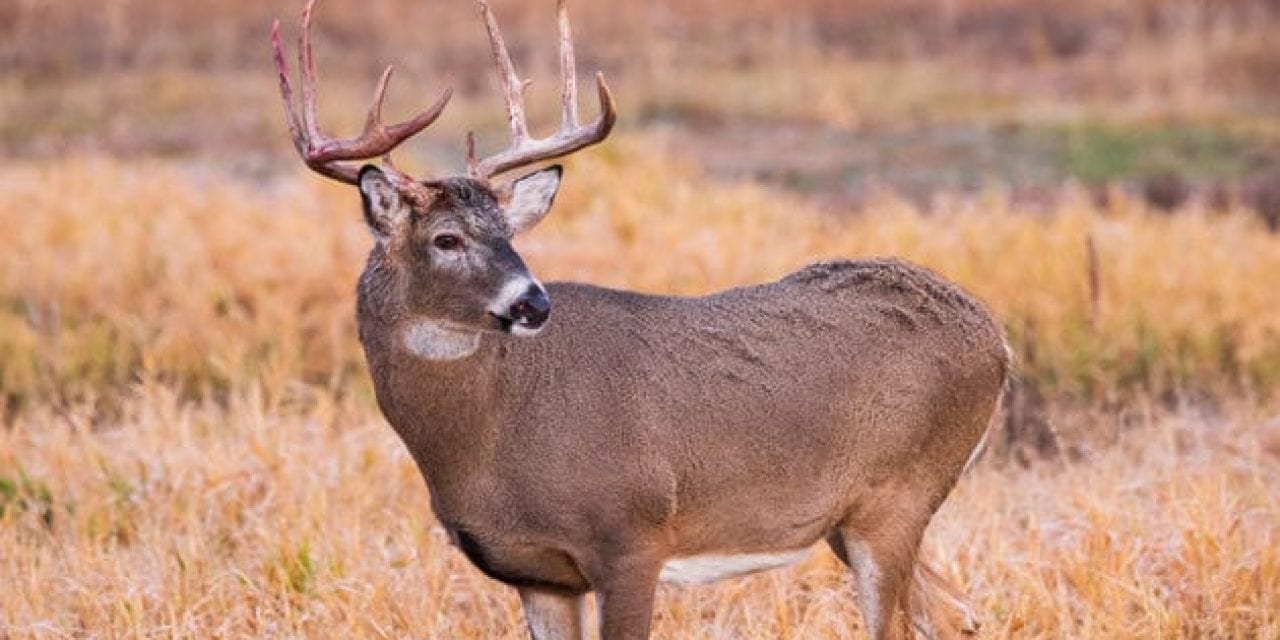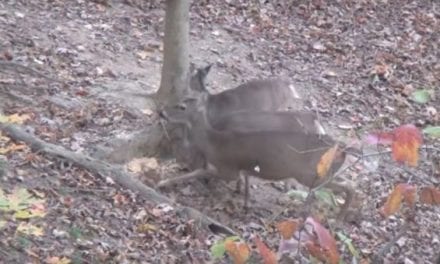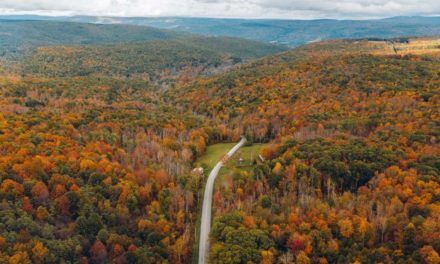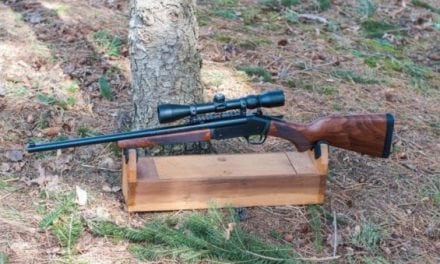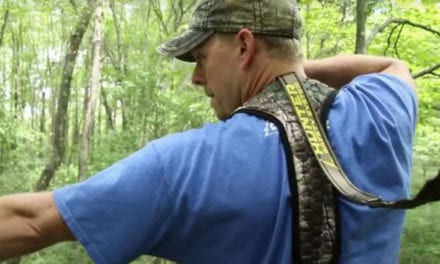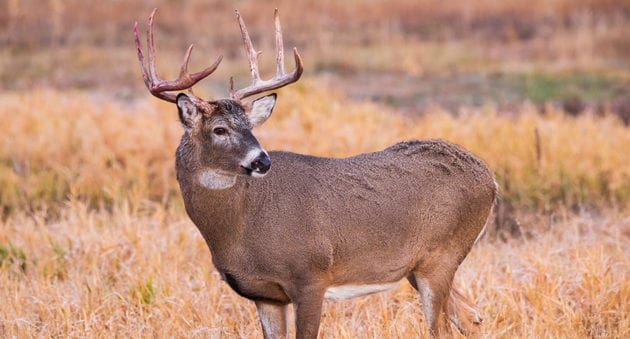
Every deer hunter wants quick, clean, and humane kills. Aiming for the deer vitals is the surest way to do that.
Whether you hunt muleys or whitetail deer, as an ethical hunter, achieving a quick kill is the ultimate goal when it comes time to loose an arrow or pull the trigger.
All you have to do is aim for the deer’s vitals. Simple right?
Well, yes and no. Simple yes, in that placing your shot in the boiler room is the surest way to bring an animal down quickly. Simple no, in that there’s plenty to consider both before and after you pull that trigger or release that arrow.
This may be deer hunting 101 for a lot of you, but it never hurts to review, and there are new deer hunters joining the ranks every year. The information given here is slanted towards bowhunting, but it applies to rifle or shotgun hunters as well. Here are the basics of deciding where to aim.
What are a deer’s vitals?
The vital area is a location where the lungs and heart are located. The heart and lungs are vital organs, hence the term. If the lung and/or heart are damaged significantly, blood loss or suffocation occurs, and death comes quickly.
Ideally you want your shot placement to hit both lungs and heart. This is why a broadside shot is the most preferred. It presents the surest scenario for your bullet or arrow to strike both organs, usually putting the deer down quickly.
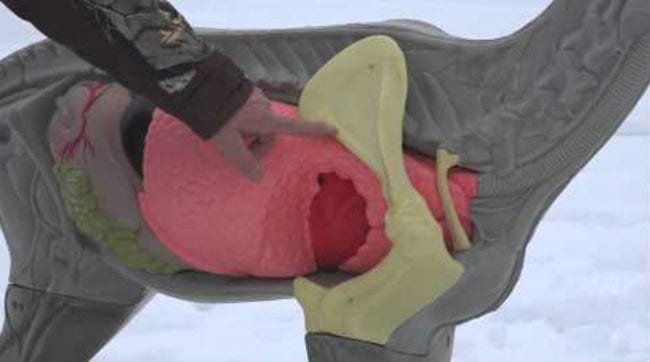
There are of course other shots that will drop a deer. Head shots and spine shots will drop a deer in its tracks, but these can be tricky. Missing a head shot by a couple inches can seriously wound, but not kill, a deer. If you should miss and hit the jaw or other area in the head, the animal may escape, only to die an agonizing death from starvation or longevity of the wound.
Take a head shot with a rifle only if you are a skilled marksman and are 100% confident of your shot. It should go without saying that a bow shot to the head is highly inadvisable.
Neck shots can be lethal if you hit the spine. Miss the spine, and you’ve probably got a wounded deer on your hands. There is little margin for error.
There are other factors to be aware of when attempting head and neck shots, but we’re going to focus on the more reliable deer vitals shot.
Deer Anatomy
Of course you need to know a few things about deer anatomy in order to make a good shot from different angles. You also need to know the capabilities of your chosen weapon. The shot you make with your .308 may not be advisable for your 50-pound longbow.
A deer’s shoulder blade provides little resistance to a rifle bullet, but that same bone could stop an arrow from reaching the vitals.
When aiming for the vitals, the primary thing you need to be aware of is the animal’s front leg and shoulder. The position of the leg dictates the position of the shoulder blade. The shoulder blade in a deer is not necessarily considered heavy bone, but it could be heavy enough to impede an arrow from traditional archery equipment.
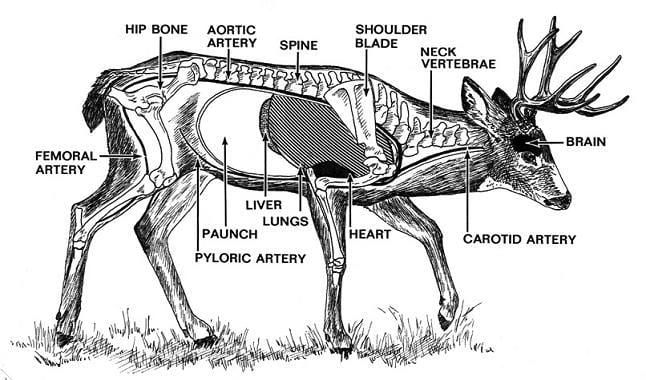
The lungs are located behind and and continue several inches rearward of the shoulder. They cover the area behind the shoulder down to the bottom chest area of the deer. The heart is located in the lower half of and between the lungs.
These vital organs comprise a group roughly the size of a slightly deflated basketball inside the chest cavity. But your aiming point shouldn’t be the entire chest cavity. “Aim small, miss small” is some time-worn advice for a reason. The difference between a kill shot and a wounded animal can be a matter of inches.
Broadside shot
Again, a broadside shot is considered the best option. It gives you the best chance for a double lung and heart shot, and a total pass through (meaning your bullet or arrow completely exits on the opposite side of the animal).
You have more aiming options when using a gun, whereas many bowhunters will wait until the deer is not only broadside, but takes a step forward so that they can put the arrow in the best spot, unchallenged by shoulder and leg bone. This is important; if you have the chance, wait for a step forward with the front leg closest to you and you’l increase your chances of missing the bone.
You will want to pick a tiny patch of hair or some other identifying feature as small as possible upon which to set your crosshairs or bow sight.
Ideally, you want your projectile to strike both lungs and the top of the heart. Remember to adjust your mental image of the vitals area to the size of deer you’re looking at. A small doe or spike buck will obviously have smaller vitals, but that size can be significantly smaller – like twice as small – as those organs on a large buck.
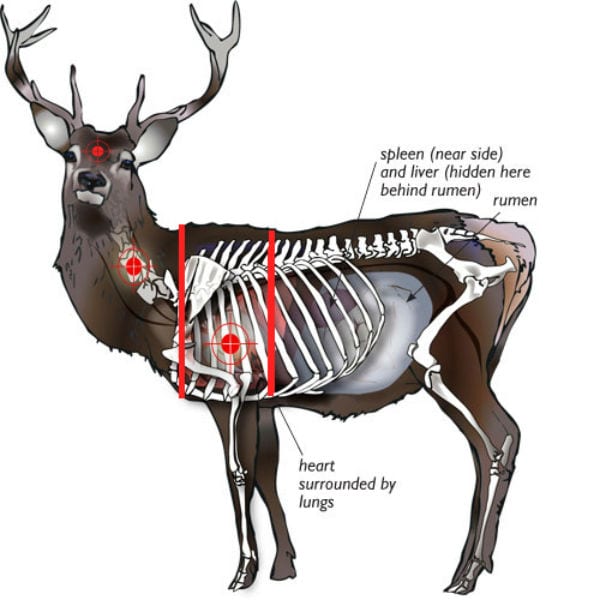
Aiming at that small spot where lungs and heart meet is also a little forgiving if your shot is off by a couple inches or more. If you miss the heart you will likely still achieve a double lung shot, which will quickly kill the deer. Miss the heart shot by a few inches rearward and you may clip the liver, which lies behind and above the heart. Chances are that if you hit the liver you will also hit lung, as the lungs partially cover the liver. A lung and liver shot is also a killing shot.
A old trick to help you mentally compute your aiming spot is to visually divide the deer’s body into three equal horizontal segments. Visualize the top of the bottom horizontal segment (the top of the lower third). Place your bow sight or crosshairs on that line and move three or four inches back from the deer’s shoulder crease.
Remember, aim small, miss small. Pick a tiny target area to aim at. This should place you squarely in the vitals, and should enable you to strike both lungs and heart.
Passing through
You also want your bullet or arrow to pass through the animal if possible. This is why shoulder shots are less than ideal. Shooting through the rib cage rather than a shoulder is a better bet for a clean pass-through, for both rifle and bow.
While a bullet will likely shatter the first shoulder before hitting the vitals, I’ve had instances where that was enough to prevent it from going completely through a deer’s body.
The reason you ideally want a pass through is because there is a better chance of having a healthy blood trail should the shot not drop the deer in its tracks. An entry hole and an exit wound mean two places for blood to exit the body, which makes your tracking job much easier.
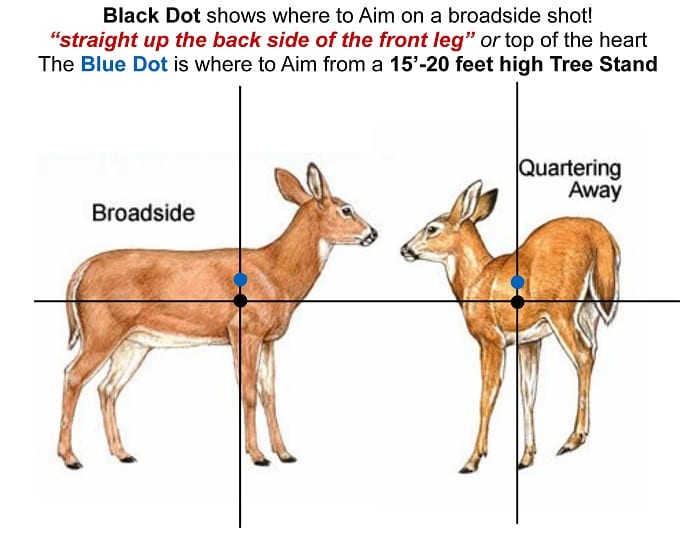
Quartering away shot
Even though a broadside deer is giving you the best and most consistent view of the vital area, a quartering away shot may actually be preferable IF the deer is not quartering away too sharply. That is, if it is more broadside than it is quartered away. A slight quartering away position opens things up a bit, moves the shoulder blade out of the way, and could enable you to hit liver, lungs, and heart.
Imagine that you are on a clock face when looking at your deer. You’re at the 6:00 position and the deer is standing broadside with its nose at the 3:00 and its tail at the 9:00 position. If the deer quarters away no more than, say, the 2:00 or 10:00 position, that would be ideal. That quartering away shot makes for a better angle in which to strike the vitals.
Any steeper of an angle than that, and you start to have the cons outweigh the pros, in my opinion.
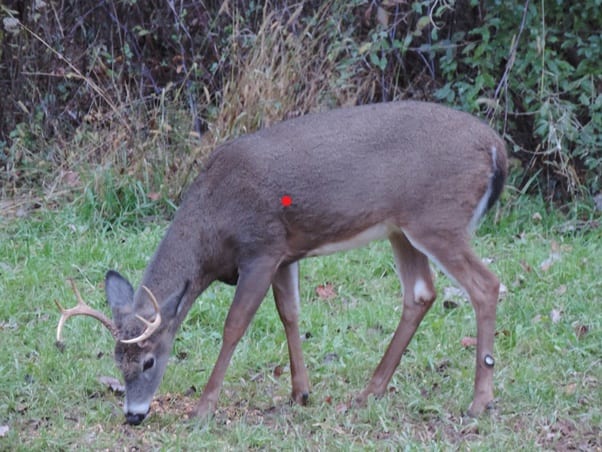
Straight on and quartering toward shot
In my opinion, these shots are inadvisable for most hunters. I realize that they can be made and, in the right circumstances, may even arguably be necessary. But I think the drawbacks far outweigh the benefits with straight on shots.
If you’re an archer, these types of shots provide too much bone and heavy tissue to pass through before you get to the vitals. The vital area is also smaller and it will be unlikely that you will hit both lungs.
In addition, it is highly improbable that you will get a pass through with either a bullet or arrow. The chances of puncturing intestines and damaging more meat is significantly greater.
It is, in my opinion, best to wait for a better shot.
The key to good shooting
Of course, the key to consistently hitting what you aim at is practice. Practice, practice, practice. And then practice some more.
Practice as often as you can. Shoot at a variety of targets, from bullseye paper targets to lifesize 3D targets. Practice from several different shooting positions and locations. If you’re a treestand hunter, practice from elevated positions.
Making ethical shots demands that you be skilled and confident in your abilities and your equipment. Practicing shooting is the only way to do that. If you can’t get to the range, spend some time visualizing and going through the motions with bow or gun in hand. It will help get you comfortable with your equipment, and it’s kind of fun if you let it be.
Good luck, good shooting, and keep practicing!
Like what you see here? Experience more articles and photographs about the great outdoors at the Facebook page, Stumpjack Outdoors.
NEXT: TIPS FOR OVERCOMING ARROW PATH OBSTRUCTIONS WHEN BOWHUNTING
WATCH
The post How to Find (and Aim for) Deer Vitals appeared first on Wide Open Spaces.

